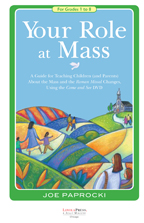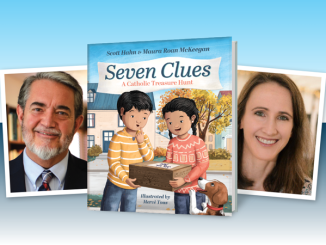We’ve talked alot about the Roman Missal changes set to begin in Advent and how we can best understand them and embrace them as catechists. I’ve offered a series of articles as well as a webinar to assist in making that happen. All along, people have been asking me, “What about actually teaching these changes to children? Will you have something available to help us?” I’m happy to say YES!
Several months ago, I met with a group of catechetical leaders to brainstorm how to teach the Roman Missal changes to children. From that research, I heard loud and clear the following 2 needs:
- We need something that is designed to not take away excessive time from our already-too-short schedule.
- We need something that doesn’t just teach the changes but teaches the liturgy as a whole and treats the changes within that context.
With that in mind, I am happy to announce a simple approach to teaching the Roman Missal changes to children that involves 3 simple components:

The Come and See (Your Role at Mass) DVD explains the elements of the Mass in a way that children can understand and enables the catechist/catechetical leader (with the assistance of the Leader Guide I’ve written’see below) to teach the Roman Missal changes within the context of teaching about the Mass.
The Come and See (Your Role at Mass) segment is divided into 2 parts:
- Liturgy of the Word (11 mins)
- Liturgy of the Eucharist (12 mins)
* (The DVD also contains 2 other segments, Ritual Matters and A Tour of the Church)

I’ve written this Leader Guide specifically for teaching children (and parents) about the Roman Missal changes within the context of teaching about the Mass, using the Come and See (Your Role at Mass) DVD.
This Leader’s Guide provides a script for the catechetical leader or catechist to pause the DVD along the way and do catechesis on the liturgy, with an emphasis on the new texts of the translation of the 3rd Edition of the Roman Missal.
Take a look at some sample pages from the Leader Guide.
p 6-7 Your Role at Mass Leader Guide
p 8-9 Your Role at Mass Leader Guide
p 24-25 Your Role at Mass Leader Guide

The children (and their parents, if you so choose) follow along using either My Own Mass Booklet (for primary age children) or the Pew Card for Mass (from publishers such as Liturgy Training Publications) to see the texts and to practice praying them aloud with the facilitator.
Consider using these resources in the following formats or adapt to your own needs:
- One Presentation conduct a 75-minute session that leads children (option: and their parents) through the entire liturgy of the Mass.
- Two Presentations conduct two 40-minute presentations for children (option: and their parents), one on the Liturgy of the Word and another on the Liturgy of the Eucharist.
- Five Presentations conduct five, 15-minute presentations for children either as part of a communal gathering before individual classes, or as part of their individual classes, covering the following segments:
- Session One Introductory Rites
- Session Two The Creed
- Session Three The Eucharistic Prayer (part I)
- Session Four The Eucharistic Prayer (part II)
- Session Five The Communion Rite and Dismissal





Joe,
I ordered the DVD “Come and See” but see that your leader guide is on back order. Any idea when that leader guide will be available?
Anne, I’m told those will be ready any day. You can contact customer service at 800-621-1008 to verify. Thanks.
Teaching the new translation of the Nicene Creed to 6th graders…here’s what I came up with:
9/6/11
IDEAS for helping students learn (or at least make sense of; i.e., become familiar with) the new translation of the Nicene Creed:
In the new translation we will say:
I believe in one God…
I believe in one Lord Jesus Christ, the Only Begotten Son of God,…
…consubstantial with the Father…and by the Holy Spirit was incarnate…
I believe in the Holy Spirit…who proceeds from the Father and the Son…
I believe in one, holy, catholic and apostolic Church…
(I added the last one because I taught the 4 Marks of the Church the week that I introduced the new translation of the Nicene Creed.
In particular explore what begotten, consubstantial and incarnate mean.
Begotten: The word begotten is inserted between only and son in the words of the Gloria and the Nicene Creed. Why? For starters, begotten reflects the biblical language in John’s Gospels and points to Jesus’ unique relationship with the Father.
Edward Sri in A Biblical Walk Through the Mass (p. 45) gives these New Testament references pointing to Jesus’ divine Sonship: Jn 5:17-18;10:30-38; 2 Cor 1:19, Col 1:13; Heb 1:1-2
All Christians are called to be children of God. All of us are adopted through grace (John 1:12-18) as sons and daughters of God . Jesus is not an adopted son, but is the divine son by nature. We are children through grace; Jesus is divine [and human]. Jesus is “consubstantial” with the Father.
For more ref. YouCat, question 74, pp. 52-53 and CCC 441-445, 454
Consubstantial: Reference Gen 1:26 where God is speaking before Adam and Eve were created. He said, Let us… Try to get students to understand God was not simply talking to himself, but that He who is one God exists in three persons.
We looked up and read John 1:1-5. Regarding the passage there were lots of quizzical looks and even a couple of ah-hah (or light bulb) moments and some “I don’t get its”. Consider explaining it “one in nature” or not “created” by God.
From A Biblical Walk Through the Mass (by Edward Sri, pp. 76-77)
consubstantial is defined “of the same substance as the Father” (in Greek homoousios).
HANDS-ON: Three separate flames when held together are one flame. Light three tapers. Hold them apart to demonstrate three separate flames. Then slightly tilted hold them together and they are one flame (of one substance).
Incarnation was Faith Vocabulary introduced in text; Jesus is fully divine and human.
The Marks of the Church …one, holy, catholic and apostolic …
YouCat, questions 129-138, pp. 81-86)
JD, thanks for sharing in such great detail. This will be helpful to many catechists.
meant to leave my comment on the “Teaching the Roman Missal Changes How s it Going So Far?” page )-:
No problem, JD, I’ll paste it there too.
Thanks Joe for this wonderful resource! I invited the parents of our RE students to join the presentations and they expressed their gratitude. There was more interest in understanding the Mass than the Roman Missal changes. Such an opportune time for us to catechize! You made it easy!
Judy, thanks for sharing the good news about people’s interest in learning about the Mass!